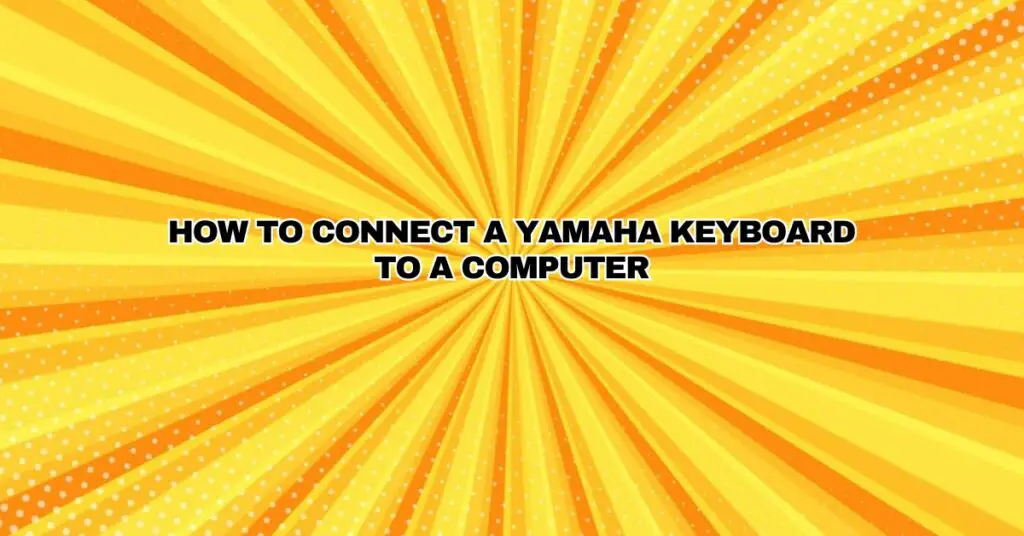Connecting your Yamaha keyboard to a computer can open up a world of possibilities, from recording your music to using virtual instruments and even taking advantage of music education software. Whether you have a digital piano, synthesizer, or MIDI keyboard, this comprehensive guide will walk you through the steps to connect your Yamaha keyboard to a computer, regardless of whether you’re using Windows or macOS.
Prerequisites:
Before you begin, you’ll need a few things:
- Yamaha Keyboard: Ensure your Yamaha keyboard has a USB-MIDI interface or a standard MIDI port. Most modern Yamaha keyboards have a USB-MIDI interface, which simplifies the connection process.
- Computer: You’ll need a Windows PC or a Mac. The steps may vary slightly between the two platforms, but the core concepts remain the same.
- USB Cable: If your keyboard has a USB-MIDI interface, you’ll need a USB Type A to Type B cable (printer cable) to connect it to your computer. If your keyboard uses standard MIDI ports, you’ll need a MIDI-to-USB interface.
- Keyboard Stand: Make sure your keyboard is set up on a stable stand or surface.
Connecting a Yamaha Keyboard to a Computer:
Here’s a step-by-step guide for connecting your Yamaha keyboard to your computer:
For Keyboards with USB-MIDI:
- Turn Off the Keyboard: Before connecting, make sure your keyboard is powered off.
- Connect the USB Cable: Plug one end of the USB cable (Type A) into an available USB port on your computer.
- Connect the Other End: Plug the other end of the USB cable (Type B) into the USB-MIDI interface port on your keyboard.
- Power On the Keyboard: Turn on your Yamaha keyboard.
- Install Necessary Drivers (Windows): If you’re using a Windows PC, your operating system might automatically recognize the keyboard and install the necessary drivers. If not, you may need to download and install the drivers from the official Yamaha website.
- Install Necessary Drivers (Mac): On a Mac, drivers are not usually required for basic MIDI functionality. The keyboard should be recognized by macOS.
- Check Connection: Open your preferred digital audio workstation (DAW) or MIDI software. Create a new project or session, and check if your Yamaha keyboard is recognized as a MIDI input device. You may need to configure this in your DAW’s settings.
- Start Making Music: Once the connection is established, you can start making music. Your keyboard’s MIDI signals will be sent to your computer for recording or playing virtual instruments.
For Keyboards with Standard MIDI Ports:
- Turn Off the Keyboard: Ensure your keyboard is powered off.
- Connect the MIDI-to-USB Interface: Plug one end of the MIDI-to-USB interface into the MIDI out port on your keyboard. Connect the other end to an available USB port on your computer.
- Power On the Keyboard: Turn on your Yamaha keyboard.
- Install Necessary Drivers (Windows): If you’re using Windows, you may need to install drivers for your MIDI-to-USB interface. Visit the manufacturer’s website to download and install the required drivers.
- Install Necessary Drivers (Mac): Mac users usually do not need additional drivers for basic MIDI functionality.
- Check Connection: Open your DAW or MIDI software, create a new project, and ensure that your keyboard is recognized as a MIDI input device in the software settings.
- Start Creating Music: Once the connection is established, you’re ready to start creating music using your keyboard as a MIDI controller. You can record, play virtual instruments, and explore various creative possibilities.
Tips for Getting the Best Experience:
- Use a DAW: To take full advantage of your connected Yamaha keyboard, use a Digital Audio Workstation (DAW) like Ableton Live, Logic Pro, Pro Tools, or a free DAW like Audacity or Cakewalk.
- Learn MIDI Basics: Understanding MIDI basics, such as channels, notes, and controllers, will help you make the most of your keyboard’s capabilities.
- Experiment with Virtual Instruments: Many DAWs come with a wide range of virtual instruments. Explore these to enhance your music production.
- Practice and Experiment: Connecting your keyboard to a computer is just the beginning. Practice, experiment, and have fun exploring new sounds and music creation techniques.
In conclusion, connecting your Yamaha keyboard to a computer is a straightforward process that can greatly expand your musical horizons. Whether you’re a beginner or an experienced musician, the ability to integrate your keyboard into your digital setup provides new opportunities for creativity, recording, and performance. With the right connections and software, you can unlock your keyboard’s full potential and enjoy a richer musical experience.


